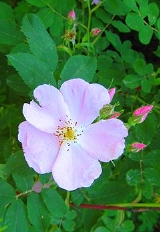
Rosa acicularis
Encyclopedia
Rosa acicularis, also known as the prickly wild rose, the prickly rose, the bristly rose and the Arctic rose, is a species of wild rose
with a Holarctic
distribution in northern regions of Asia
, Europe
, and North America
.
shrub
growing 1–3 m tall. The leaves
are pinnate, 7–14 cm long, with three to seven leaflets. The leaflets are ovate, with wavy margins. The flower
s are pink (rarely white), 3.5–5 cm diameter; the hips
are red, pear-shaped to ovoid, 10–15 mm diameter.
The ploidy
of this species is variable. Authorities list it as tetraploid, hexaploid in North America (subsp. sayi), and octoploid in Eurasia (subsp. acicularis). On the northern Great Plains its populations are generally tetraploid.
North America
This native species of the U.S. and Canadian northern Great Plains
is the provincial flower of Alberta
. It is not as common in the Parkland region of the Canadian Prairie provinces as Rosa woodsii
(Woods' rose), but is the most abundant rose in the boreal forests of northern Canada and Alaska.
Rose
A rose is a woody perennial of the genus Rosa, within the family Rosaceae. There are over 100 species. They form a group of erect shrubs, and climbing or trailing plants, with stems that are often armed with sharp prickles. Flowers are large and showy, in colours ranging from white through yellows...
with a Holarctic
Holarctic
The Holarctic ecozone refers to the habitats found throughout the northern continents of the world as a whole. This region is divided into the Palearctic, consisting of Northern Africa and all of Eurasia, with the exception of Southeast Asia and the Indian subcontinent, and the Nearctic,...
distribution in northern regions of Asia
Asia
Asia is the world's largest and most populous continent, located primarily in the eastern and northern hemispheres. It covers 8.7% of the Earth's total surface area and with approximately 3.879 billion people, it hosts 60% of the world's current human population...
, Europe
Europe
Europe is, by convention, one of the world's seven continents. Comprising the westernmost peninsula of Eurasia, Europe is generally 'divided' from Asia to its east by the watershed divides of the Ural and Caucasus Mountains, the Ural River, the Caspian and Black Seas, and the waterways connecting...
, and North America
North America
North America is a continent wholly within the Northern Hemisphere and almost wholly within the Western Hemisphere. It is also considered a northern subcontinent of the Americas...
.
Description
Rosa acicularis is a deciduousDeciduous
Deciduous means "falling off at maturity" or "tending to fall off", and is typically used in reference to trees or shrubs that lose their leaves seasonally, and to the shedding of other plant structures such as petals after flowering or fruit when ripe...
shrub
Shrub
A shrub or bush is distinguished from a tree by its multiple stems and shorter height, usually under 5–6 m tall. A large number of plants may become either shrubs or trees, depending on the growing conditions they experience...
growing 1–3 m tall. The leaves
Leaf
A leaf is an organ of a vascular plant, as defined in botanical terms, and in particular in plant morphology. Foliage is a mass noun that refers to leaves as a feature of plants....
are pinnate, 7–14 cm long, with three to seven leaflets. The leaflets are ovate, with wavy margins. The flower
Flower
A flower, sometimes known as a bloom or blossom, is the reproductive structure found in flowering plants . The biological function of a flower is to effect reproduction, usually by providing a mechanism for the union of sperm with eggs...
s are pink (rarely white), 3.5–5 cm diameter; the hips
Rose hip
The rose hip, or rose haw, is the fruit of the rose plant, that typically is red-to-orange, but ranges from dark purple to black in some species. Rose hips begin to form in spring, and ripen in late summer through autumn.-Usage:...
are red, pear-shaped to ovoid, 10–15 mm diameter.
The ploidy
Ploidy
Ploidy is the number of sets of chromosomes in a biological cell.Human sex cells have one complete set of chromosomes from the male or female parent. Sex cells, also called gametes, combine to produce somatic cells. Somatic cells, therefore, have twice as many chromosomes. The haploid number is...
of this species is variable. Authorities list it as tetraploid, hexaploid in North America (subsp. sayi), and octoploid in Eurasia (subsp. acicularis). On the northern Great Plains its populations are generally tetraploid.
North America
This native species of the U.S. and Canadian northern Great Plains
Great Plains
The Great Plains are a broad expanse of flat land, much of it covered in prairie, steppe and grassland, which lies west of the Mississippi River and east of the Rocky Mountains in the United States and Canada. This area covers parts of the U.S...
is the provincial flower of Alberta
Alberta
Alberta is a province of Canada. It had an estimated population of 3.7 million in 2010 making it the most populous of Canada's three prairie provinces...
. It is not as common in the Parkland region of the Canadian Prairie provinces as Rosa woodsii
Rosa woodsii
Rosa woodsii is a species of rose known by the common name Woods' rose. It is native to North America including much of Canada and Alaska and the western and central United States. It grows in a variety of habitat types, including disturbed areas....
(Woods' rose), but is the most abundant rose in the boreal forests of northern Canada and Alaska.
See also
- Rosa arkansana - Wild Prairie Rose
- List of Rosa species

